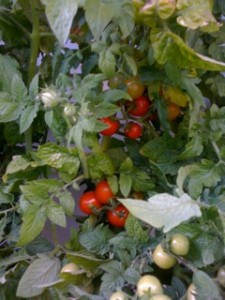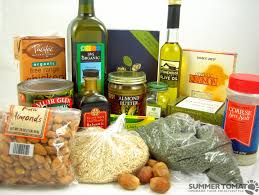 Raw Food, that is.
Raw Food, that is.
Incorporating more raw food into your diet is one of the best moves you can make towards optimum health. It’s not necessary to toss out your stove to enjoy the benefits of eating raw foods, simply add more of them to each meal.
Why raw?
Raw food is “living food”. As opposed to dead foods, (anything that is processed and/or cooked), living foods still have their enzymes intact. Enzymes are catalysts for every function of the body from blinking to breathing.
Cooking also destroys food’s naturally occurring vitamins and strips away most antioxidants. (One exception is that cooked tomatoes have more lycopene, a nutrient known to prevent prostate cancer, than raw tomatoes). Our bodies were designed to eat primarily raw foods and many of our modern diseases can be controlled or eliminated with a raw food diet.
I first became aware of the benefits of eating living foods about 30 years ago. When planning the “real estate” of my plate, I strive to ensure at least 2/3 is plant based and of that, at least half is raw. Lately I’ve worked at increasing the ratio of raw to cooked foods based on the miracles eating raw has brought to others.
A few years ago a friend of mine lost his sister to cancer. A cleaner in the hospital where his sister breathed her last breathe had gotten acquainted with the family over the course of her illness and suggested that her cancer could have been prevented with a raw food diet. My friend was intrigued and bought the book the woman had recommended. He began eating raw and within about two weeks he noticed his asthma was gone. He no longer needed medication that he had taken nearly his entire life, over 50 years.
There are many cases of diabetes retreating from a raw food diet. Drew Carey of the Price is Right has reportedly cured his diabetes and lost significant pounds by eating raw. Mike Adams, founder of the web site Natural News (which has over 100 raw food articles) cured his pre-diabetic condition by eating a diet that is 60 to 90% raw. Unfortunately, most doctors believe diabetes is incurable and must be treated with expensive medications.
One of my daughters has struggled with her weight since she was a teenager, despite working out religiously and eating “healthy”. When she began eating a primarily raw food diet she miraculously went from a size 12 to a six and for the first time in years, her stomach doesn’t hurt whenever she eats. She reports having more energy and even though it takes some extra effort to seek raw food, she vows she will never go back.
The main benefits of eating raw include:
#1 More energy. The body spends less energy digesting food and the aforementioned enzymes are not destroyed, adding to one’s vitality.
#2 Elimination is drastically improved on a raw diet. A properly functioning digestive system is vital to maintaining optimal health.
#3 More time: it takes less time to prepare raw food (once you know some of the tricks) and people on raw food diets often report that they require less sleep.
#4 Weight loss: 82.5% of people who switched to raw food diets reported losing weight.
#5 Mental Health: 87.5% of raw “foodies” report improved mental health in areas such as optimism, memory, focus, patience, and even creativity, without the dreadful side effects of anti-depressants
#6 Lowered cardiovascular disease, including lowered cholesterol and triglycerides. C-reactive protein, an inflammatory molecule linked to heart disease, diabetes and other chronic disease is also lowered with raw food.
#7 Improved menstrual cycles; stress reduction, reduced breast and prostate cancers.
Studies show that cooked foods increase our white blood cell activity, essentially meaning our bodies see cooked food as invaders. This explains why many “dis-eases” can be treated by switching to a raw food diet.
It’s not difficult to increase your raw food consumption. An easy way is to eat fruit for breakfast. My favourite breakfast is a sliced banana or two with some berries and/or a sliced peach with a splash of coconut milk. If you eat enough fruit, it will get you through the morning. Fruit is also a good snack anytime of day.
Another great way to increase your raw food intake is to eat salads. They don’t have to be the standard lettuce and tomato salad. You can literally turn any veggies into a satisfying meal. I invented a salad a couple years ago that is a summer favourite of mine and it has no lettuce in it at all. See Nasturtium Salad.
Raw foods can also be added to cooked foods. A baked potato can be topped with any number of chopped raw veggies, including cabbage, broccoli, onions, and/or tomatoes.
I have attended a number of raw food workshops given by Afke Zonderland and sponsored by a local health food store, Amaranth Whole Foods Market. Afke is a marvelous woman who showed us how to make Walnut-Zucchini Crackers and some fabulous dairy-free dips.
She made a sweet potato and celery soup with cooked sweet potatoes and served it warm. I liked that she wasn’t a raw food “purist”: she argued that after a day on the ski hill she didn’t want to eat something cold and that the idea is to eat as many raw foods as possible but not be militant about it.
Afke is all about spreading the message of healthy eating. She has dozens of recipes on her website at www.foodsalive.ca. Not all her recipes are completely raw but they all incorporate some raw elements, which is really the point. She also recommended David Wolfe’s book Superfoods. His web site is www.DavidWolfe.com. I have included more resources below.
I encourage you to take small steps towards incorporating more living food into your diet. By eating less dead food, you are sure to enjoy some of the benefits without having to diet (aka, “suffer”!
Rah! Rah! Raw!
Sources:
www.NaturalNews.com has dozens of Articles on raw food including: http://www.NaturalNews.com/z030137_lifestyle_health.html
http://altmedicine.about.com/od/pop…
http://jn.nutrition.org/cgi/content…
http://www.nzherald.co.nz/diabetes/…
http://www.iowasource.com/food/lenk…
http://www.google.com search Raw Food for tons more resources.





